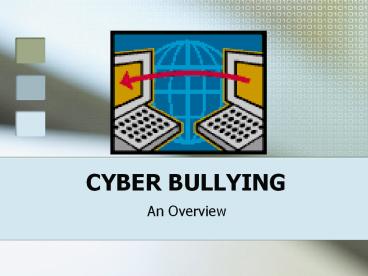CYBER BULLYING - PowerPoint PPT Presentation
1 / 14
Title:
CYBER BULLYING
Description:
An Overview CYBER BULLYING IS The use of electronic communication technologies to intentionally engage in repeated or widely disseminated acts of cruelty towards ... – PowerPoint PPT presentation
Number of Views:684
Avg rating:3.0/5.0
Title: CYBER BULLYING
1
CYBER BULLYING
- An Overview
2
CYBER BULLYING IS
- The use of electronic communication technologies
to intentionally engage in repeated or widely
disseminated acts of cruelty towards another that
result in emotional harm - Also known as
- Electronic Bullying, Electronic Aggression
- Online Social Cruelty
- Responding to the Challenge of Electronic
Aggression, Nancy Willard
3
CYBER BULLIES TECHNOLOGY
- Cell phones
- Pager text messages
- Instant messaging
- Defamatory personal web sites
- Defamatory online personal polling web sites
- Chat rooms
4
DIFFERENCES
- BULLYING
- DIRECT
- Often occurs on
- school property
- Poor relationships
- with teachers
- Fear retribution
- Physical Hitting, Punching Shoving
- Verbal Teasing, Name calling Gossip
- Nonverbal Use of gestures Exclusion
- www.stopbullyingnow.hrsa.gov
- CYBERBULLYING
- ANONYMOUS
- Occurs most often off
- school property
- Good relationships with teachers
- Fear loss of technology privileges
- Further under the radar than bullying
- Emotional reactions cannot be determined
- McKenna Bargh, 2004 Ybarra Mitchell, 2004
5
CYBER BULLY CATEGORIES
- Inadvertent
- Role-play
- Responding
- May not realize its cyber bullying
- Vengeful Angel
- Righting wrongs
- Protecting themselves
- Mean Girls
- Bored Entertainment
- Ego based promote own social status
- Often do in a group
- Intimidate on and off line
- Need others to bully if isolated, stop
- Power-Hungry
- Want reaction
- Controlling with fear
- Revenge of the Nerds
- (Subset of Power-Hungry)
- Often Victims of school-yard bullies
- Throw cyber-weight around
- Not school-yard bullies like Power-Hungry Mean
Girls
Parry Aftab. Esq., Executive Director,
WiredSafety.org
6
CYBER BULLYING TYPES
- Flaming Online fights using electronic
messages with angry and vulgar language - Harassment Repeatedly sending offensive, rude,
and insulting messages - Cyber stalking Repeatedly sending messages
that include threats of harm or are highly
intimidating. Engaging in other on-line
activities that make a person afraid for his or
her own safety - Denigration Dissing someone online. Sending
or posting cruel gossip or rumors about a person
to damage his or her reputation or friendships
7
CYBER BULLYING TYPES
- Impersonation Pretending to be someone else
and sending or posting material online that makes
that person look bad, gets that person in trouble
or danger, or damages that persons reputation or
friendships - Outing and Trickery Sharing someones secret
or embarrassing information online. Tricking
someone into revealing secrets or embarrassing
information which is then shared online - Exclusion Intentionally excluding someone from
an on-line group, like a buddy list - Nancy Willard, M.S., J.D., Director of the
Center for Safe and Responsible Internet Use
8
CYBER BULLYING PREVALENCE
- Cyber bullying typically starts at about 9 years
of age and usually ends after 14 years of age
after 14, it becomes cyber or sexual harassment
due to nature of acts and age of actors Aftab
9
CYBER BULLYING PREVALENCE
- Aftabs statistics www.aftab.com
- 90 of middle school students they polled had
their feelings hurt online - 65 of their students between 8-14 have been
involved directly or indirectly in a cyber
bullying incident as the cyber bully, victim or
friend - 50 had seen or heard of a website bashing of
another student - 75 had visited a website bashing
- 40 had their password stolen and changed by a
bully (locking them out of their own account) or
sent communications posing as them - Problems in studies not assessing the real
thing - i.e. Only 15 of parents polled knew what cyber
bullying was
10
CYBER BULLYING LEGAL ISSUES
- Educators Guide To Cyber bullying
- Addressing the Harm of On-line Social Cruelty
- (Nancy Willard, 2005)
- Law Enforcement should be contacted if
- educator becomes aware of
- Death threats or threats of other forms of
violence to a person or property - Excessive intimidation or extortion
- Threats or intimidation that involve any form of
bias or discrimination - Any evidence of sexual exploitation
11
CURRENT CYBER BULLYINGPROGRAMS RESPONSES
- What Everyone Needs to Know About Cyber bullying
(aftab.com) - Education of Children
- All actions have consequences
- Cyber bullying hurts
- Cyber bully and accomplices often become the
target of cyber bullying themselves - Care about others and stand up for whats right
12
CURRENT CYBER BULLYINGPROGRAMS RESPONSES
- Comprehensive Plan (Willard, 2005)
- Schools
- Policies concerning misuse of technology
- Evaluate how staff is and can more effectively
monitor Internet use - Parents
- Discuss cyber bullying
- Supervise and increase effective monitoring of
Internet use - Since more adults supervise, more children will
hide - activities, strategies needed to change social
norms - in these on-line works, empower the victim with
- knowledge how to prevent respond, to
- discourage bullies from engaging in such
activities.
13
CURRENT CYBER BULLYINGPROGRAMS RESPONSES
- Schools should
- Focus on values of kindness and respectful human
relations - Enhancement of empathic awareness
- Develop effective problem solving skills
- Empowerment of bystanders
14
CURRENT CYBER BULLYING ASSESSMENT
- What Everyone Needs to Know About Cyber bullying
(Aftab) - Assessment to differentiate between rude
communications and cyber bullying - 1- Kind of Threats
- 2- Frequency of Threat
- 3- Source of Threats
- 4- Nature of the Threats
- The more frequent, the greater the threat, the
mention of more dangerous methods the
involvement of third parties tends to increase
the seriousness of the threat - Knowing the cyber bully may increase or decrease
the threat































